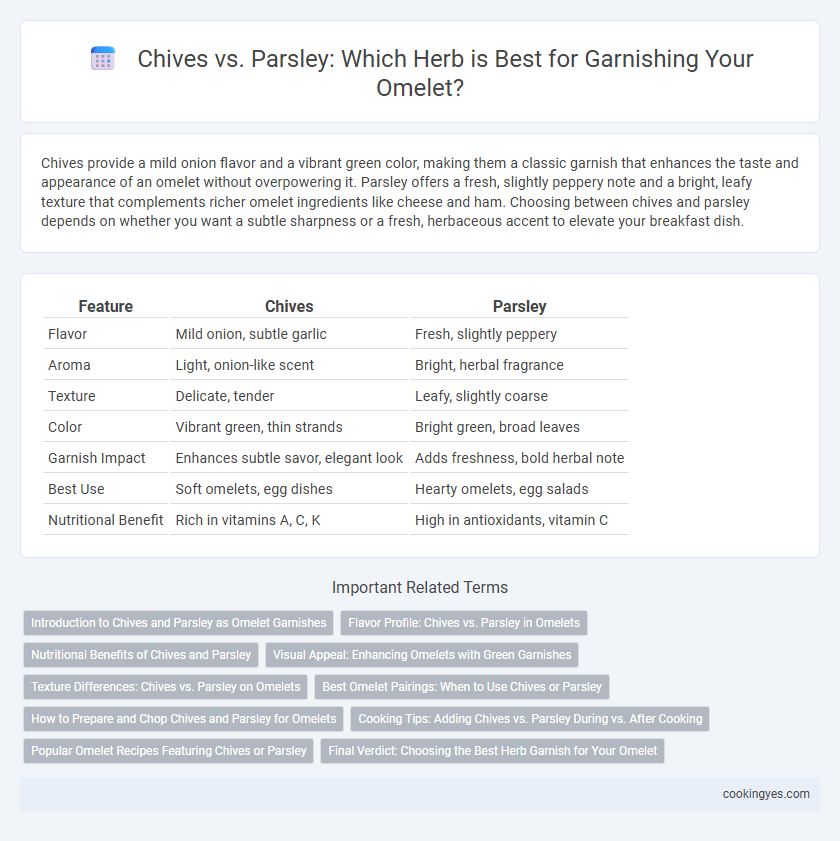Chives provide a mild onion flavor and a vibrant green color, making them a classic garnish that enhances the taste and appearance of an omelet without overpowering it. Parsley offers a fresh, slightly peppery note and a bright, leafy texture that complements richer omelet ingredients like cheese and ham. Choosing between chives and parsley depends on whether you want a subtle sharpness or a fresh, herbaceous accent to elevate your breakfast dish.
Table of Comparison
| Feature | Chives | Parsley |
|---|---|---|
| Flavor | Mild onion, subtle garlic | Fresh, slightly peppery |
| Aroma | Light, onion-like scent | Bright, herbal fragrance |
| Texture | Delicate, tender | Leafy, slightly coarse |
| Color | Vibrant green, thin strands | Bright green, broad leaves |
| Garnish Impact | Enhances subtle savor, elegant look | Adds freshness, bold herbal note |
| Best Use | Soft omelets, egg dishes | Hearty omelets, egg salads |
| Nutritional Benefit | Rich in vitamins A, C, K | High in antioxidants, vitamin C |
Introduction to Chives and Parsley as Omelet Garnishes
Chives offer a mild onion flavor and delicate texture that enhances omelets by adding a subtle, fresh bite without overpowering the other ingredients. Parsley provides a bright, slightly peppery taste along with vibrant green color, lending a fresh and herbaceous note that complements the creamy eggs. Both herbs are rich in vitamins A and C, making them nutritious garnishes that elevate the flavor and appearance of omelets.
Flavor Profile: Chives vs. Parsley in Omelets
Chives provide a mild onion-like flavor that enhances the savory richness of an omelet without overpowering it. Parsley offers a fresh, slightly peppery taste that adds brightness and a subtle earthiness to the dish. Choosing between chives and parsley depends on whether you prefer a delicate allium note or a crisp herbaceous accent in your omelet garnish.
Nutritional Benefits of Chives and Parsley
Chives enhance omelets with a rich source of vitamins A, C, and K, along with antioxidants that support immune health and reduce inflammation. Parsley also offers high levels of vitamins A and C, plus folate and iron, promoting blood health and bone strength. Both herbs add distinct flavors and valuable nutrients, making them excellent choices for a nutrient-dense omelet garnish.
Visual Appeal: Enhancing Omelets with Green Garnishes
Chives and parsley both provide vibrant green hues that enhance the visual appeal of omelets. Chives offer a fine, delicate texture and rich, deep green color that create an elegant, refined look when thinly sliced on top. Parsley brings a fuller, leafy appearance with a bright, fresh green shade, adding a more rustic, hearty garnish to the dish.
Texture Differences: Chives vs. Parsley on Omelets
Chives provide a delicate, mild onion flavor with a tender yet slightly crisp texture that enhances the softness of an omelet without overpowering it. Parsley offers a more robust, slightly coarse texture and a fresh, peppery taste that adds a pronounced contrast to the creamy eggs. Choosing chives results in a subtle textural complement, while parsley introduces a firmer bite that stands out in every mouthful.
Best Omelet Pairings: When to Use Chives or Parsley
Chives provide a mild onion flavor that complements creamy omelets, especially those with cheese or mushroom fillings, enhancing savory depth without overpowering. Parsley offers a fresh, slightly peppery taste that brightens vegetable or herb-heavy omelets, adding vibrant color and a subtle herbal note. Choosing between chives and parsley depends on the omelet's ingredients and desired flavor profile, with chives lending a delicate sharpness and parsley contributing a refreshing finish.
How to Prepare and Chop Chives and Parsley for Omelets
To prepare chives for an omelet garnish, rinse them under cold water, pat dry, and finely slice them into thin, delicate rings to preserve their mild onion flavor and vibrant green color. For parsley, wash thoroughly, remove thick stems, and chop the leaves coarsely or finely depending on preference, ensuring a fresh, herbaceous taste that complements the eggs. Both herbs should be chopped just before serving to maintain their aroma and texture, enhancing the overall flavor and presentation of the omelet.
Cooking Tips: Adding Chives vs. Parsley During vs. After Cooking
Chives add a mild onion flavor and are best sprinkled on omelets after cooking to preserve their delicate texture and bright taste, enhancing the garnish without overpowering the eggs. Parsley offers a fresh, slightly peppery flavor that can withstand light heat, making it suitable for adding during the last minute of cooking to infuse subtle herbal notes. For optimal flavor and presentation, use chives as a finishing touch and parsley as a subtle seasoning incorporated near the end of the cooking process.
Popular Omelet Recipes Featuring Chives or Parsley
Chives and parsley both elevate omelet flavor profiles, with chives offering a mild onion-like taste ideal for classic French-style omelets, herb and cheese omelets, and smoked salmon variants. Parsley provides a fresh, slightly peppery finish, enhancing Mediterranean omelets, vegetable-loaded omelets, and Mediterranean herb blends. Popular recipes frequently pair chives with creamy fillings and parsley with vibrant, vegetable-based ingredients to maximize aromatic complexity.
Final Verdict: Choosing the Best Herb Garnish for Your Omelet
Chives offer a mild onion flavor and delicate texture, making them an ideal garnish to enhance an omelet without overpowering its taste. Parsley provides a fresh, slightly peppery note and vibrant green color that brightens both the look and flavor profile of the dish. For the best herb garnish, chives are preferred when seeking subtlety and elegance, while parsley suits those who want a more pronounced, refreshing herbal accent.
Chives vs Parsley for omelet garnish Infographic

 cookingyes.com
cookingyes.com